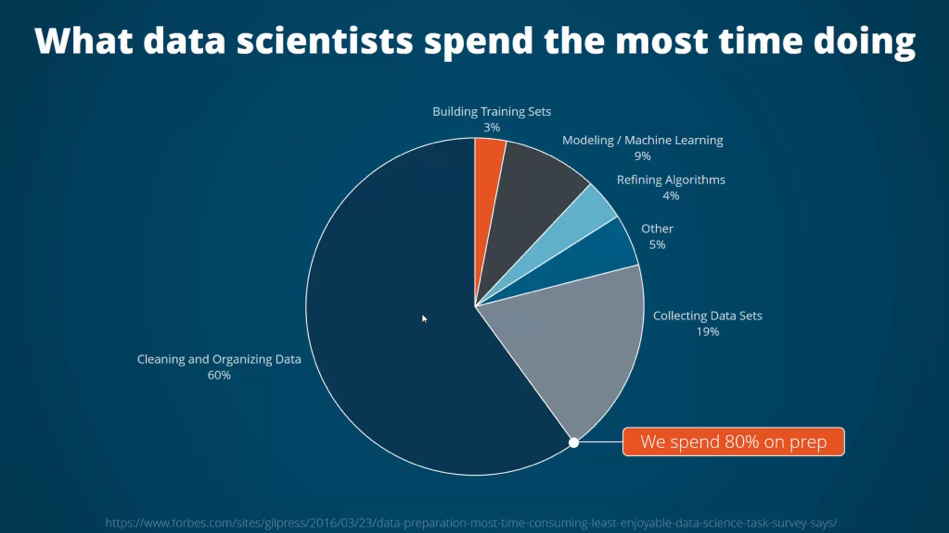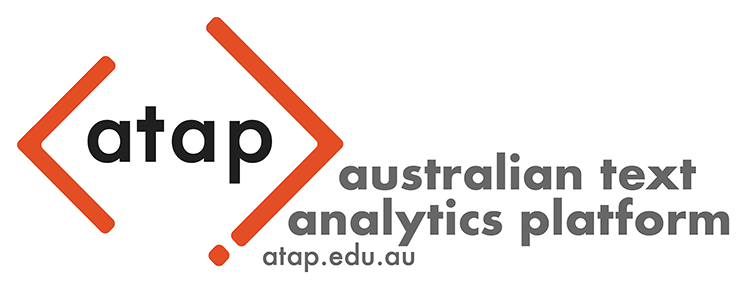Introducing data preparation concepts

This graphic is, sadly, all too true. Data scientists and those who are using data as part of their research spend much of their time preparing their dataset and transforming its structure into a format that can be used (often referred to as data wrangling or data munging). The Australian Text Analytics Platform will offer a range of tools to assist in cleaning text data and performing other preliminary operations which can prepare the data for analysis. ATAP analysis notebooks assume a common data structure, however the platform will provide notebooks containing code for transforming data into the structure that is needed for the procedure(s) in the analysis notebooks.
There are two main processes that are needed to prepare text data for analysis , cleaning and annotation, and the ones that you will need to use will depend on the dataset that you are using.
Common Cleaning Techniques
Making all of the text lower case: This ensures that e.g. dog and Dog will not be treated as different items and is important if you are going to use analytic methods which rely on counting items. However, if you are planning to extract entities from your text data, retaining capital letters may be important.
Standardising spelling: At least for English text, there are some well-known spelling variations, some with a geographical context (colour/color) and some that are more a matter of personal preference (recognise/recognize). As with case, standardising spelling ensures that pairs like the examples are treated as tokens of the same type.
Removing stopwords: Stopwords are function words that are not interesting for many analyses and we can safely remove them from our data using a stoplist. The 20 most frequently occurring words in the British National Corpus are the, of , and, a, in, to, it, is, was, to, I, for, you, he, be, with, on, that, by , and at. The equivalent list for the Corpus of Contemporary American English (COCA) is the, be, and, of , a, in, to, have, to, it, I, that, for, you, he, with, on, do, say and _ this. Some of the differences between the two are because the COCA counts are of lemmas (see Lemmatization below) which are the base forms of a word (think _ dog and dogs). Packages such as nltk and spaCy include standard stoplists for various languages, and it is possible to specify other words to be excluded.
Removing punctuation: Punctuation can change how a text analysis package identifies a word. For instance to be sure that dog and dog? are not treated as different items, removing punctuation is good practice.
Removing numbers: Sometimes the presence of numbers in documents can lead to artefacts in analysis. For example, in a collection of documents with page numbering, the numbers might show up as collocates of words or as part of a topic in a topic model. To avoid this, removing numbers is also good practice. This can present a challenge where numbers might be of interest (e.g. a study of mathematics textbooks).
Removing whitespace: Whitespace can be another possible source of artefacts in analysis, especially if the source material uses a lot of tabs.
Annotation
Annotation is the process of adding information to your base dataset in order to make it possible to apply analytic techniques. In some cases, this may be a manual process. For example, much of the annotation which is described in the Text Encoding Initiative Guidelines requires a human making decisions although, in some cases, manual annotation processes may also be scaled up to large text corpora using text classification or information extraction technologies.
However some annotation can be carried out automatically, and there are two important kinds of annotation for text which fall into this category.
- Part-of-speech tagging (POS-tagging): For some analytic procedures, knowing the part of speech (or class of words) that an item belongs to is important. For languages where good pre-trained models exist, this annotation can be carried out automatically to a high level of accuracy – for English, we expect an accuracy rate better than 95%. POS-taggers generally provide more information than just whether an item is a noun or a verb, they also distinguish singular and plural forms of nouns and tell us whether a verb’s form is present tense form or a past tense. The tag sets which are used can therefore be quite extensive, and there are various tag sets in use such as the Penn Treebank tags and the CLAWS tags used by the British National Corpus.
LADAL has some excellent resources that discuss POS tagging in more detail.
- Lemmatization: The distinctions between different forms of a single lexeme can be a hindrance in analysis especially if we are interested in lexical semantics in texts. Lemmatization identifies the base forms of words (or lemmas) in a text so that all forms of an item are treated together. For example: dog and dogs will both be instances of the lemma DOG. eat, eats, eating and ate will all be treated as tokens of the lemma EAT. As noted above, POS-tags give information about the form of words and are generally part of the annotation in lemmatization. A lemma, along with a POS- tag, can be reconstructed to the original form if necessary.
